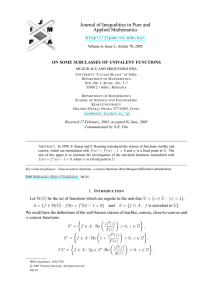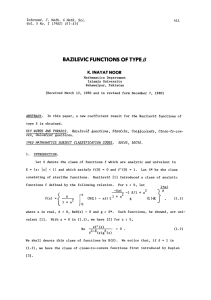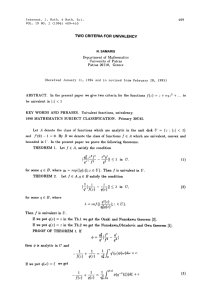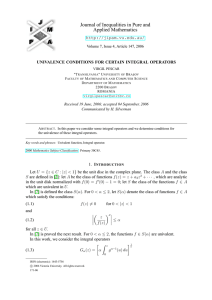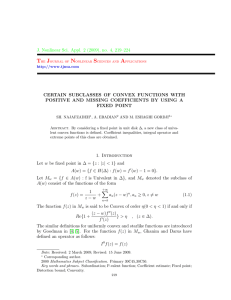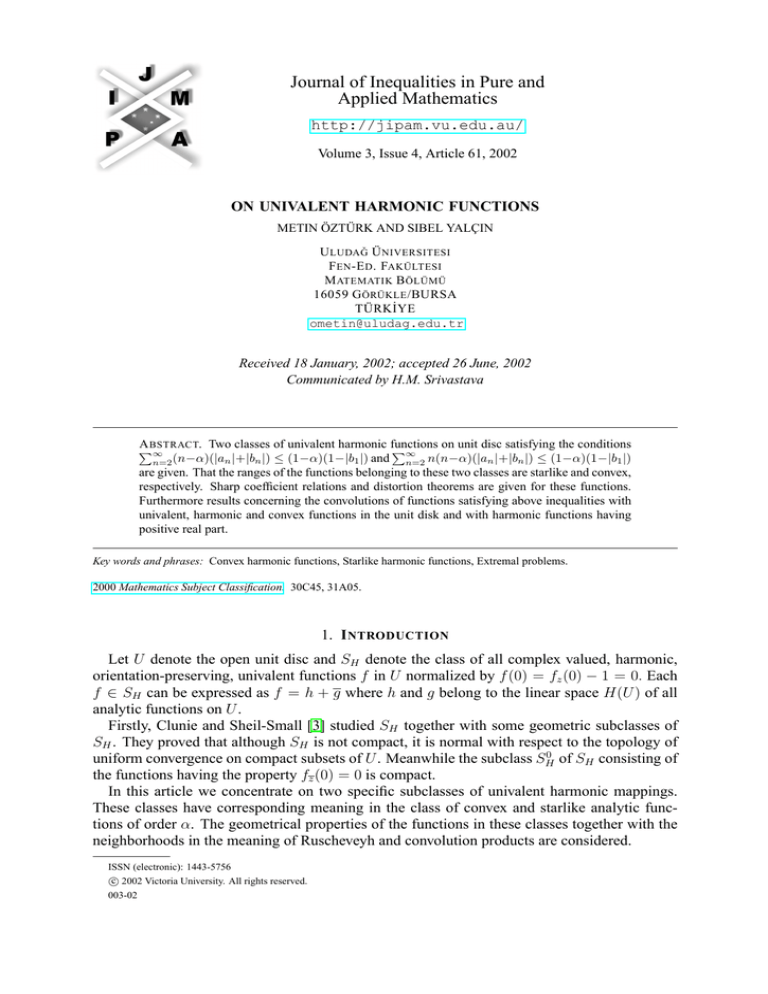
Journal of Inequalities in Pure and
Applied Mathematics
http://jipam.vu.edu.au/
Volume 3, Issue 4, Article 61, 2002
ON UNIVALENT HARMONIC FUNCTIONS
METIN ÖZTÜRK AND SIBEL YALÇIN
U LUDA Ǧ Ü NIVERSITESI
F EN -E D . FAKÜLTESI
M ATEMATIK B ÖLÜMÜ
16059 G ÖRÜKLE /BURSA
TÜRK İYE
ometin@uludag.edu.tr
Received 18 January, 2002; accepted 26 June, 2002
Communicated by H.M. Srivastava
A BSTRACT. Two classes of univalent harmonic functions
on unit disc satisfying the conditions
P
P∞
∞
(n−α)(|a
|+|b
|)
≤
(1−α)(1−|b
|)
and
n(n−α)(|a
n
n
1
n |+|bn |) ≤ (1−α)(1−|b1 |)
n=2
n=2
are given. That the ranges of the functions belonging to these two classes are starlike and convex,
respectively. Sharp coefficient relations and distortion theorems are given for these functions.
Furthermore results concerning the convolutions of functions satisfying above inequalities with
univalent, harmonic and convex functions in the unit disk and with harmonic functions having
positive real part.
Key words and phrases: Convex harmonic functions, Starlike harmonic functions, Extremal problems.
2000 Mathematics Subject Classification. 30C45, 31A05.
1. I NTRODUCTION
Let U denote the open unit disc and SH denote the class of all complex valued, harmonic,
orientation-preserving, univalent functions f in U normalized by f (0) = fz (0) − 1 = 0. Each
f ∈ SH can be expressed as f = h + g where h and g belong to the linear space H(U ) of all
analytic functions on U .
Firstly, Clunie and Sheil-Small [3] studied SH together with some geometric subclasses of
SH . They proved that although SH is not compact, it is normal with respect to the topology of
0
uniform convergence on compact subsets of U . Meanwhile the subclass SH
of SH consisting of
the functions having the property fz (0) = 0 is compact.
In this article we concentrate on two specific subclasses of univalent harmonic mappings.
These classes have corresponding meaning in the class of convex and starlike analytic functions of order α. The geometrical properties of the functions in these classes together with the
neighborhoods in the meaning of Ruscheveyh and convolution products are considered.
ISSN (electronic): 1443-5756
c 2002 Victoria University. All rights reserved.
003-02
2
M ETIN Ö ZTÜRK AND S IBEL YALÇIN
2. T HE C LASSES HS(α) AND HC(α)
Let Ur = {z : |z| < r, 0 < r ≤ 1} and U1 = U . Harmonic, complex-valued, orientationpreserving, univalent mappings f defined on U can be written as
f (z) = h(z) + g(z),
(2.1)
where
(2.2)
h(z) = z +
∞
X
an z
n
g(z) =
and
n=2
∞
X
bn z n
n=1
are analytic in U .
Denote by HS(α) the class of all functions of the form (2.1) that satisfy the condition
∞
X
(2.3)
(n − α)(|an | + |bn |) ≤ (1 − α)(1 − |b1 |)
n=2
and by HC(α) the subclass of HS(α) that consists of all functions subject to the condition
∞
X
n(n − α)(|an | + |bn |) ≤ (1 − α)(1 − |b1 |),
n=2
where 0 ≤ α < 1 and 0 ≤ |b1 | < 1. The corresponding subclasses of HS(α) and HC(α) with
b1 = 0 will be denoted by HS 0 (α) and HC 0 (α), respectively. When α = 0, these classes are
denoted by HS and HC and have been studied by Y. Avcı and E. Zlotkiewicz [2]. If |b1 | = 1
and (2.3) is satisfied, then the mappings z + b1 z are not univalent in U and of no interest.
If h, g, H, G are of the form (2.2) and if
f (z) = h(z) + g(z) and F (z) = H(z) + G(z)
then the convolution of f and F is defined to be the function
f ∗ F (z) = z +
∞
X
a n An z n +
n=2
∞
X
bn Bn z n
n=1
while the integral convolution is defined by
f F (z) = z +
∞
X
an A n
n=2
n
n
z +
∞
X
bn Bn
n=1
n
zn.
The δ−neighborhood of f is the set
(
)
∞
X
Nδ (f ) = F :
n(|an − An | + |bn − Bn |) + |b1 − B1 | ≤ δ
n=2
(see [1], [5]). In this case, let us define the generalized δ−neighborhood of f to be the set
(
)
∞
X
N (f ) = F :
(n − α)(|an − An | + |bn − Bn |) + (1 − α)|b1 − B1 | ≤ (1 − α)δ .
n=2
J. Inequal. Pure and Appl. Math., 3(4) Art. 61, 2002
http://jipam.vu.edu.au/
O N U NIVALENT H ARMONIC F UNCTIONS
3
3. M AIN R ESULTS
First, let us give the interrelations between the classes HS(α) and HS, HC(α) and HC.
Theorem 3.1. HS(α) ⊂ HS and HC(α) ⊂ HC. Consequently HS 0 (α) ⊂ HS 0 and
HC 0 (α) ⊂ HC 0 . In particular if 0 ≤ α1 ≤ α2 < 1 then HS(α2 ) ⊂ HS(α1 ) and HC(α2 ) ⊂
HC(α1 ).
Proof. Since
(3.1)
∞
X
∞
X
n−α
n(|an | + |bn |) ≤
n=2
and
∞
X
n=2
2
n (|an | + |bn |) ≤
n=2
1−α
(|an | + |bn |) ≤ 1 − |b1 |
∞
X
n(n − α)
n=2
1−α
(|an | + |bn |) ≤ 1 − |b1 |
we have the proof of theorem.
Corollary 3.2.
(i) Each member of HS 0 (α) maps U onto a domain starlike with respect
to the origin.
(ii) Functions of the class HC 0 (α) maps Ur onto convex domains.
Theorem 3.3. The class HS(α) consist of univalent sense preserving harmonic mappings.
Proof. From [2, Theorem 1] for f in HS(α) and for z1 , z2 ∈ U with z1 6= z2 we have
!
∞
X
|h(z1 ) − h(z2 )| ≥ |z1 − z2 | 1 − |z2 |
n|an |
n=2
and
|g(z1 ) − g(z2 )| ≤ |z1 − z2 | |b1 | + |z2 |
∞
X
!
n|bn | .
n=2
When we consider the relation (3.1), it follows that
|f (z1 ) − f (z2 )| ≥ |z1 − z2 | 1 − |b1 | − |z2 |
∞
X
!
n(|an | + |bn |)
n=2
= |z1 − z2 | 1 − |b1 | − |z2 |
∞
X
(n − α)(|an | + |bn |)
n=2
−α|z2 |
∞
X
!
(|an | + |bn |)
n=2
≥ |z1 − z2 |[1 − |b1 | − |z2 |(1 − α)(1 − |b1 |) − α|z2 |(1 − |b1 |)]
= |z1 − z2 |(1 − |b1 |)(1 − |z2 |) > 0.
So f is univalent. Since
Jf (z) = |h0 (z)|2 − |g 0 (z)|2
≥ (|h0 (z)| + |g 0 (z)|) 1 − |z|
∞
X
n|an | − |b1 | − |z|
n=2
∞
X
!
n|bn |
n=2
≥ (|h0 (z)| + |g 0 (z)|)(1 − |b1 |)(1 − |z|) > 0
f is sense preserving.
J. Inequal. Pure and Appl. Math., 3(4) Art. 61, 2002
http://jipam.vu.edu.au/
4
M ETIN Ö ZTÜRK AND S IBEL YALÇIN
Remark 3.4.
(i) The functions fn (z) = z + n−1
eiθ z are in HS(α) and the sequence
n+1
converges uniformly to z + eiθ z. Thus the class HS(α) is not compact.
(ii) If f ∈ HS(α), then for each r, 0 < r < 1, r−1 f (rz) ∈ HS(α).
(iii) If f ∈ HS(α) and f0 (z) = (f (z) − b1 f (z))/(1 − |b1 |2 ) then f0 ∈ HS 0 (α), but f (z) =
f0 (z) + b1 f0 (z) may not be in HS(α).
(iv) If f = h + g ∈ HS 0 (α) then the function
Z
1
F (z) =
0
f (tz)
dt =
t
Z
z
0
h(u)
du +
u
Z
z
0
g(u)
du
u
satisfies (2.3) with b1 = 0, hence F (z) is a convex harmonic mapping. Convexity
of F (z) however, does not imply starlikeness of f (z) (or even univalence) in general
situation.
Theorem 3.5. Each function in the class HS 0 (α) maps disks Ur , r ≤
The constant 1−α
is best possible.
2−α
1−α
2−α
onto convex domains.
Proof. If f ∈ HS 0 (α) and r, 0 < r < 1 be fixed, then r−1 f (rz) ∈ HS 0 (α). We must find an
upper bound for r such that
∞
X
n(n − α)
n=2
1−α
(|an | + |bn |)rn−1 ≤ 1.
Since f ∈ HS 0 we have
∞
X
n(n − α)
n=2
1−α
(|an | + |bn |)r
n−1
=
∞
X
n(|an | + |bn |)
n=2
(n − α)rn−1
≤1
1−α
provided (n − α)rn−1 /(1 − α) ≤ 1 which is true if r ≤ (1 − α)/(2 − α).
Theorem 3.6. If f ∈ HS(α), then
|f (z)| ≤ |z|(1 + |b1 |) +
(1 − α2 )(1 − |b1 |) 2
|z|
2
and
|z|2
|f (z)| ≥ (1 − |b1 |) |z| − (1 − α )
2
2
.
Equalities are attained by the functions
fθ (z) = z + |b1 |eiθ z +
1 − |b1 |
(1 − α2 )z 2
2
for properly chosen real θ.
Proof. We have
2
|f (z)| ≤ |z|(1 + |b1 |) + |z|
∞
X
(|an | + |bn |).
n=2
J. Inequal. Pure and Appl. Math., 3(4) Art. 61, 2002
http://jipam.vu.edu.au/
O N U NIVALENT H ARMONIC F UNCTIONS
5
Since
∞
X
(|an | + |bn |) ≤
n=2
1
α
(1 − α)(1 − |b1 |) + (|a2 | + |b2 |)
2
2
∞
−
1X
(n − α − 2)(|an | + |bn |)
2 n=3
1
α
(1 − α)(1 − |b1 |) + (1 − α)(1 − |b1 |)
2
2
1
=
(1 − α2 )(1 − |b1 |)
2
≤
it follows that
|f (z)| ≤ |z|(1 + |b1 |) +
(1 − α2 )(1 − |b1 |) 2
|z|
2
for z in U.
Similarly we get
2
|f (z)| ≥ |z|(1 − |b1 |) − |z|
∞
X
(|an | + |bn |)
n=2
2
(1 − α )(1 − |b1 |) 2
|z|
≥ |z|(1 − |b1 |) −
2
2
2 |z|
.
= (1 − |b1 |) |z| − (1 − α )
2
The classes HS(α) and HC(α) are uniformly bounded, hence they are normal.
Remark 3.7. We can give a similar result for HC(α) to that given for HS(α). As the proof is
similar we shall omit it.
Theorem 3.8. If f ∈ HC(α), then
3 − α − 2α2
(1 − |b1 |)|z|2
2α
and
3 − α − 2α2 2
|f (z)| ≥ (1 − |b1 |) |z| −
|z| .
2α
Equalities are attained by the functions
3 − α − 2α2 2
fθ (z) = z + |b1 |eiθ z +
z
2α
for properly chosen real θ.
Theorem 3.9. The extreme points of HS 0 (α) are only the functions of the form: z + an z n or
z + bm z m with
1−α
1−α
|an | =
,
|bm | =
,
0 ≤ α < 1.
n−α
m−α
Proof. Suppose that
∞
X
f (z) = z +
(an z n + bn z n )
|f (z)| ≤ |z|(1 + |b1 |) +
n=2
is such that
∞
X
n−α
n=2
1−α
J. Inequal. Pure and Appl. Math., 3(4) Art. 61, 2002
(|an | + |bn |) < 1,
ak > 0.
http://jipam.vu.edu.au/
6
M ETIN Ö ZTÜRK AND S IBEL YALÇIN
Then, if λ > 0 is small enough we can replace ak by ak − λ, ak + λ and we obtain two functions
f1 (z), f2 (z) that satisfy the same condition and for which one gets f (z) = 21 [f1 (z) + f2 (z)].
Hence f is not a possible extreme point of HS 0 (α).
Let now f ∈ HS 0 (α) be such that
∞
X
n−α
(3.2)
(|an | + |bn |) = 1,
ak 6= 0, bl 6= 0
1−α
n=2
If λ > 0 is small enough and if µ, ζ with |µ| = |ζ| = 1 are properly chosen complex numbers,
then leaving all but ak , bl coefficients of f (z) unchanged and replacing ak , bl by
1−α
1−α
ak + λ
µ,
bl − λ
ζ
k−α
l−α
1−α
1−α
ak − λ
µ,
bl + λ
ζ
k−α
l−α
we obtain functions f1 (z), f2 (z) that satisfy (3.2) and such that f (z) = 21 [f1 (z)+ f2 (z)]. In this
case f can not be an extreme point. Thus for |an | = (1 − α)/(n − α), |bm | = (1 − α)/(m − α),
f (z) = z + an z n or f (z) = z + bm z m are extreme points of HS 0 (α).
Similarly we can obtain that the following result is true.
Theorem 3.10. The extreme points of HC 0 (α) are only the functions of the form: z + an z n or
z + bm z m with
1−α
1−α
|an | =
,
|bm | =
,
0 ≤ α < 1.
n(n − α)
m(m − α)
0
Let KH
denote the class of harmonic univalent functions of the form (2.1) with b1 = 0 that
map U onto convex domains. It is known [3, Theorem 5.10] that the sharp inequalities
2|An | ≤ n + 1,
2|Bn | ≤ n − 1
are true.
Theorem 3.11. Suppose that
F (z) = z +
∞
X
(An z n + Bn z n )
n=2
0
KH
.
belongs to
Then
(i) If f ∈ HC 0 (α) then f ∗ F is starlike univalent and f F is convex.
(ii) If f (z) satisfies the condition
∞
X
n2 (n − α)(|an | + |bn |) ≤ 1 − α
n=2
then f ∗ F is convex univalent.
Proof. We justify the case (i). Since
∞
∞
X
X
Bn An (n − α)(|an An | + |bn Bn |) =
n(n − α) |an | + |bn | n
n
n=2
n=2
≤
∞
X
n(n − α)(|an | + |bn |) ≤ 1 − α
n=2
it follows that f ∗ F is in HS 0 (α). Namely f ∗ F is starlike univalent.
J. Inequal. Pure and Appl. Math., 3(4) Art. 61, 2002
http://jipam.vu.edu.au/
O N U NIVALENT H ARMONIC F UNCTIONS
Furthermore, the transformation
Z
1
0
7
f ∗ F (tz)
dt = f F (z)
t
0
now shows that f F ∈ HC (α).
Let S denote the class of analytic univalent functions of the form F (z) = z +
∞
P
An z n . It is
n=2
well known that the sharp inequality |An | ≤ n is true.
Theorem 3.12. If f ∈ HC 0 (α) and F ∈ S then for |ε| ≤ 1, f ∗ (F + εF ) is starlike univalent.
Proof. Since
∞
X
∞
X
(n − α)(|an An | + |bn Bn |) ≤
n=2
n(n − α)(|an | + |bn |) ≤ 1 − α
n=2
it follows that f ∗ (F + εF ) is starlike univalent.
Let PH0 denote the class of functions F complex and harmonic in U, f = h + g such that
Re f (z) > 0, z ∈ U and
H(z) = 1 +
∞
X
n
An z ,
G(z) =
n=1
∞
X
Bn z n .
n=2
It is known [4, Theorem 3] that the sharp inequalities
|An | ≤ n + 1,
|Bn | ≤ n − 1
are true.
Theorem 3.13. Suppose that
F (z) = 1 +
∞
X
(An z n + Bn z n )
n=1
belongs to PH0 . Then
(i) If f ∈ HC 0 (α) then for 32 ≤ |A1 | ≤ 2,
convex.
(ii) If f (z) satisfies the condition
∞
X
1
f
A1
∗ F is starlike univalent and
1
f
A1
F is
n2 (n − α)(|an | + |bn |) ≤ 1 − α
n=2
then
1
f
A1
∗ F is convex univalent.
Proof. We justify the case (ii). Since
∞
X
∞
X
an A n
bn Bn
n+1
n−1
2
n(n − α)(|
|+|
|) ≤
n (n − α) |an |
+ |bn |
A
A
|A
|n
|A1 |n
1
1
1
n=2
n=2
≤
∞
X
n2 (n − α)(|an | + |bn |) ≤ 1 − α
n=2
1
f
A1
∗ F is convex univalent.
J. Inequal. Pure and Appl. Math., 3(4) Art. 61, 2002
http://jipam.vu.edu.au/
8
M ETIN Ö ZTÜRK AND S IBEL YALÇIN
0
Remark 3.14. If f ∈ HS 0 (α) and F ∈ KH
, thenf ∗ F need
not be univalent. For example, if
1−α n
z
z
f (z) = z + n−α z and F (z) = Re 1−z + i Im (1−z)2 then f ∗ F (z) = z + (n+1)(1−α)
z n is
2(n−α)
not univalent in U. But f F is univalent and starlike.
Theorem 3.15. Let
∞
X
(an z n + bn z n )
f (z) = z + b1 z +
n=2
is a member of HC(α). If δ ≤
1−α
(1
2−α
− |b1 |), then N (f ) ⊂ HS(α).
P
n
n
Proof. Let f ∈ HC(α) and F (z) = z + B1 z + ∞
n=2 (An z + Bn z ) belong to N (f ). We have
∞
X
(1 − α)|B1 | +
(n − α)(|An | + |Bn |)
n=2
≤ (1 − α)|B1 − b1 | + (1 − α)|b1 |
∞
∞
X
X
+
(n − α)(|An − an | + |Bn − bn |) +
(n − α)(|an | + |bn |)
n=2
n=2
≤ (1 − α)δ + (1 − α)|b1 | +
1
2−α
∞
X
n(n − α)(|an | + |bn |)
n=2
1−α
≤ (1 − α)δ + (1 − α)|b1 | +
(1 − |b1 |)
2−α
≤ 1 − α.
Hence, for
δ≤
1−α
(1 − |b1 |)
2−α
F (z) ∈ HS(α).
R EFERENCES
[1] O. ALTİNTAŞ, Ö. ÖZKAN AND H.M. SRIVASTAVA, Neighborhoods of a class of analytic functions with negative coefficients, Appl. Math. Lett., 13 (2000), 63–67.
[2] Y. AVCİ AND E. ZLOTKIEWICZ, On harmonic univalent mappings, Ann. Universitatis Mariae
Curie-Sklodowska, XLIV(1), Sectio A (1990), 1–7.
[3] J. CLUNIE AND T. SHEIL-SMALL, Harmonic univalent functions, Ann. Acad. Sci. Fen. Series A.
I, Math., 9 (1984), 3–25.
[4] Z.J. JAKUBOWSKI, W. MAJCHRZAK AND K. SKALSKA, Harmonic mappings with a positive
real part, Materialy XIV Konferencji z Teorii Zagadnien Ekstremalnych, Lodz. (1993), 17–24.
[5] St. RUSCHEWEYH, Neighborhoods of univalent functions, Proc. Amer. Math. Soc., 81 (1981),
521–528.
J. Inequal. Pure and Appl. Math., 3(4) Art. 61, 2002
http://jipam.vu.edu.au/

